The third in my series about UNESCO sites off the beaten track takes us to the vast continent of Africa. There are a total of 145 UNESCO Heritage Sites in Africa spread around the continent.
I reached out to some of my fellow bloggers for their ideas, from Roman ruins, rock-hewn churches to the Okavango Delta, they came up trumps!
*This site uses affiliate links and I may earn a small commission when you use my links and make a purchase without incurring an additional fee yourself.
Thank you for supporting this website. See my disclaimer page for more details.
Table of Contents
Lesser-known UNESCO Heritage Sites in Africa
Twyfelfontein, Namibia
by Emma from Wanderlust and Wet Wipes

Located in Damaraland, West Namibia, close to the Skeleton Coast, Twyfelfontein has one of the highest concentrations rock engravings in Africa. Just getting there is an adventure – whether you travel from the capital, Windhoek, from Etosha to the North West, or you’re coming through Swakopmund to the South East, it’s a remote location, to say the least. It was made a World Heritage Site in June 2007 and is Namibia’s first and only UNESCO World Heritage Site to date
Driving along gravel roads for hundreds of miles with the dramatic Namibian landscape on either side, it’s hard not to be impressed before you even get there.
When you get there, there’s well-organised parking and a lovely front office complete with a little gift shop and a small museum depicting the area’s history. There are a number of different walking routes that you can take around the site and these are marked clearly on a map at the visitor centre. These are of varying lengths and take visitors to see different pieces of art.
A vivid red-rock, open-air art gallery, Twyfelfontein (meaning “fountain of doubt”) has more than 2,000 well-preserved rock engravings all carved and etched into the big bright stones. Many of the paintings and carvings are of local game and wildlife such as rhinoceros, elephant, ostrich and giraffe. There are also drawings of humans and other animals.
When you leave Twyfelfontein, be sure to make a stop Damara Living Museum. There are a few of these dotted around Namibia under the umbrella of the Living Culture Foundation which helps local communities to set them up. It’s a great opportunity to learn about the indigenous tribes while helping to support them financially.
Ganvie Lake Village, Benin
by Laura from Laure Wanders

Ganvie Lake Village in Benin is often dubbed “the Venice of Africa“. It’s a unique and very authentic village, built on the blue waters of Lake Nakoue, near Cotonou. The Tofinu people have lived on these waters for centuries, ever since seeking refugee from the Fon Tribe of Abomey, who were hunting for tribesmen to sell into slavery to the Portuguese.
The Fon tribe believed that water demons lived in the lake, which made it the perfect place for the Tofinu people to escape to. They now have their own shops, church, mosque, hospital, etc. on the lake. Only their school and cemetery was built on solid land. Ganvie is believed to be the largest lake village in Africa, though this is not official.
The easiest way to visit the village is by taking the tourist boat, which costs 10.000 CFA and includes a guide/driver. The tour takes about two hours and offers a fascinating insight into this alternative way of living. You’ll be able to sail through the village, eat a traditional dish at the restaurant and set foot on one of the houses built on stilts. And chances are that you’ll be the only tourist here!
YOU MIGHT ALSO LIKE: UNESCO Sites Off the Beaten Track – Europe
Kasubi Tombs, Uganda
by Ashley from Ashley Abroad
The Kasubi Tombs in Kampala, Uganda, are the burial site for members of the royal family of Buganda, which is a subnational kingdom in Uganda. One of three of Uganda’s UNESCO Heritage sites, the Kasubi Tombs are an important example of traditional architecture. The building is constructed primarily of natural materials, such as wood, thatch, and reed.
But the true significance of the Kasubi Tombs lies not in the physical, but the spiritual. The site is the final resting ground of four kabakas, a term meaning king of the Buganda kingdom. This site is of great spiritual significance to the Ganda people because according to their traditions, they are ruled by two kings; one spiritual, the other human. As UNESCO states, “The site represents a place where communication links with the spiritual world are maintained.”
The site is a major spiritual centre for the Ganda people; in fact, it is the most active religious place in the Baganda kingdom. As a tomb building has existed in this spot since the 13th century, the building represents both the continuity and identity of the Ganda people. The Kasubi Tombs are an important historical site for not only the Ganda people but for Uganda as a whole.
The Kasubi Tombs are well worth a visit if you’re ever in Kampala, Uganda’s often over-looked capital.
The Cradle of Humankind in South Africa
By Lerato from Life from a Bag

A visit to South Africa would be incomplete without visiting The Cradle of Humankind – one of the world’s most important Heritage Sites.
Located in the North West province, just an hour from Johannesburg, Sterkfontein Caves in Maropeng is one of South Africa’s ten UNESCO World Heritage sites and where the most complete skull of an adult Australopithecus was found in 1947.
The skull is estimated to be over a 2.3-million-year-old and she was named Mrs. Ples which derives from the scientific name Plesianthropus transvaalensis (near-man from the Transvaal). Fossils found at Maropeng date back more than 4-million years and are commonly accepted as representative of the birth of humanity.
South Africa is a great destination to visit if you want to hike the world’s oldest mountain. The country is also home to three meteor craters including the largest verified impact crater on Earth. A large percentage of the world’s dinosaur bones were discovered in South Africa including a new species of dinosaurs that were found in August 2019. With many historical sites, you can help but wonder if South Africa is truly the Cradle of Humankind.
Okavango Delta, Botswana
by Chris from Amateur Traveller

The Okavango Delta in Botswana may not be as well-known for an African safari as parks in Tanzania, Kenya or South Africa but this UNESCO World Heritage site may now be my favourite part of Africa.
The Okavango Delta is a vast area where the rains come down from the mountains in Angola and end in the sands of the Kalahari desert. In between, where they spread out through northern Botswana you will find an amazing diversity of wildlife including one-third of Africa’s elephants.
Unlike parks like Ngorongoro Crater or Kruger, I have spent a day at places in the delta when we didn’t see any other vehicles for hours. The best way to claim your own corner of the delta is to take a mobile safari where you are staying in the park itself. Of course, you do sometimes have to put up with noisy neighbours like a lion that strode 50 feet outside our camp, roaring to find the rest of her pride.
The most popular time to visit the park is in and around June. The rainy season in Botswana starts in December and many of the mobile safaris cease running for a few months as portions of the delta will become impassible at that time. Also at that time, the rains will release clouds of flying ants and termites. While having termites in your morning washbasin is anything but fun, these clouds of insects will attract flocks of migratory birds coming from as far away as Europe.
If a mobile safari in Botswana’s Okavango Delta is not already on your bucket list, it should be!
YOU MIGHT ALSO LIKE: UNESCO Sites Off the Beaten Track – The Middle East
Mapungubwe National Park, South Africa
by Alma from Roaming Fox
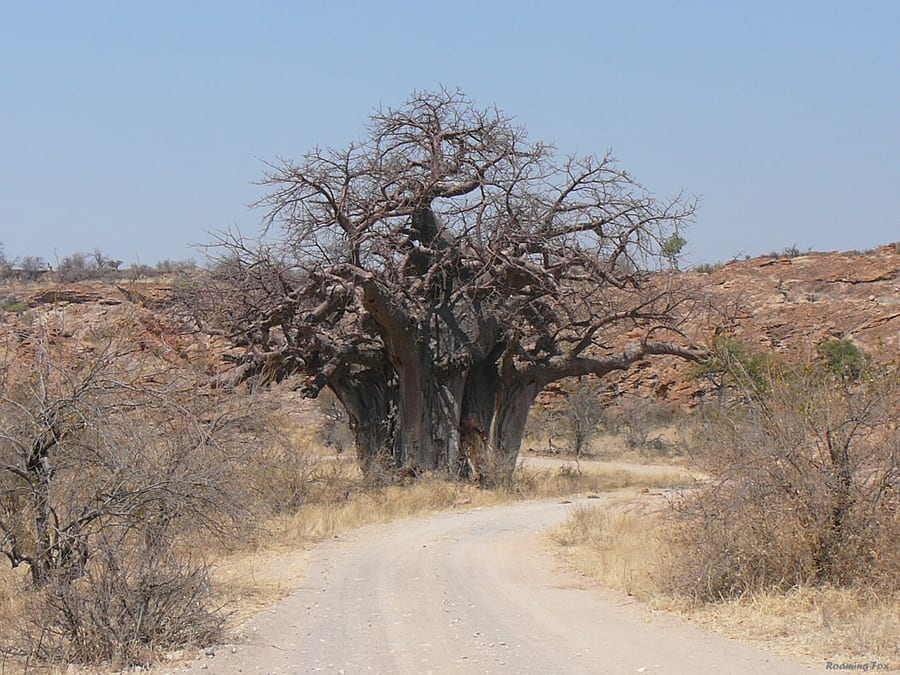
Situated in the north on the border of Botswana as well as Zimbabwe, not only is Mapungubwe known for its historical significance but is also a national park in South Africa.
This Sanparks Transfrontier conservation park is broken up into two areas, a west side and an east side.
Mapungubwe is steeped in culture and history boasting an archaeological site and a heritage walk to visit a significant graveyard at the top of Mapungubwe Hill, with remnants from Middle Iron Age farmers and traders.
Today the national park houses an Interpretation Centre that is a highly applauded architectural achievement which won the World Architectural Building of the Year Award in 2009.
Within the park all the roads are gravel. You can self-drive or go on a guided game drive or guided morning walk to view mammals, birds, fauna and flora.
The park houses many species of animals including four of the Big 5. Beautiful specimens of the baobab, as well as the Nyala and Mopani trees, are also visible. Its rock formations are also outstanding.
If you go on the Tree Top Raised Board Walk you may be lucky to see elephants below you without having any fear of being charged by them.
It is a malaria area, so make sure to bring insect repellent and malaria prophylaxis.
Rates: Standard Conservation Fee of R218 per adult per day and R109 per child per day for foreign visitors is charged. This excludes accommodation.
Volubilis, Morocco
by Mike from Time Travel Turtle
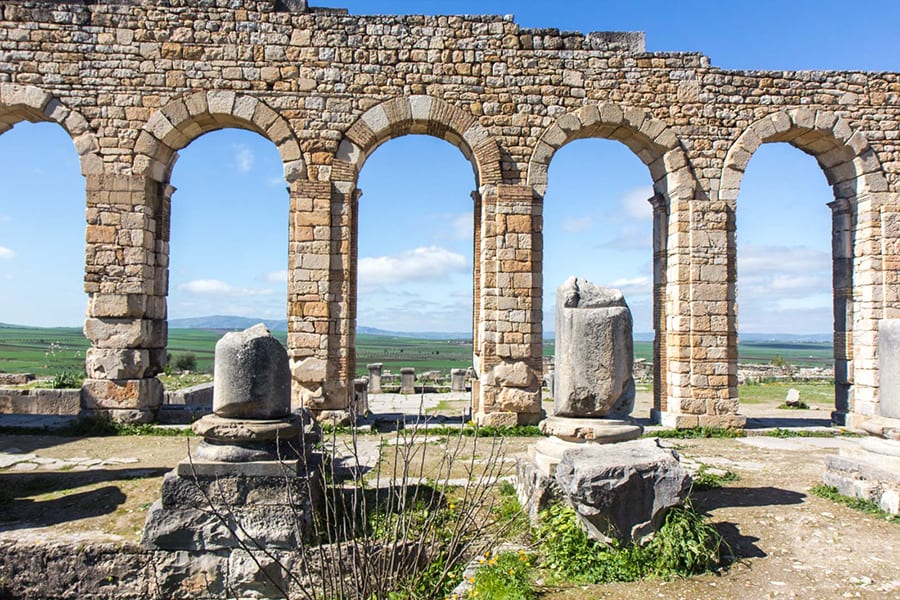
When you think of Morocco, you don’t normally think of the Romans, but their empire did indeed stretch this far. At the archaeological site of Volubilis, you can find the best-preserved city in Morocco from the Roman times.
The main reason the Romans established Volubilis was as a base for agriculture in the region – but the city itself grew into a grand urban centre. You can still see the remains of a large basilica, a temple, and a triumphal arch. Even the houses of the wealthy residents were quite striking, and you can see evidence of that with the fine mosaic floors that are still here.
The site isn’t enormous, like Pompeii, but it will take about an hour to see everything properly. You can walk down the broad avenues lined with columns, climb through the ruins of the suburbs, and see the opulent public buildings. Perhaps it’s not as impressive as the archaeological sites you’ll find in Italy, but it’s an interesting change from the usual Moroccan World Heritage Sites.
If you’re interested in visiting Volubilis, it’s near the town of Moulay Idriss and you can walk to the site in about 30 minutes. However, most people come on a tour from nearby Meknes (a World Heritage Site itself), which is about 30 kilometres away. The entrance fee is 70 dirhams (about US$7) and there’ll probably be plenty of guys at the entry offering to show you around for a small fee if you prefer.
YOU MIGHT ALSO LIKE: UNESCO Sites Off the Beaten Track – Asia
Rainforests of the Atsinanana, Madagascar
by Brianna from Curious Travel Bug
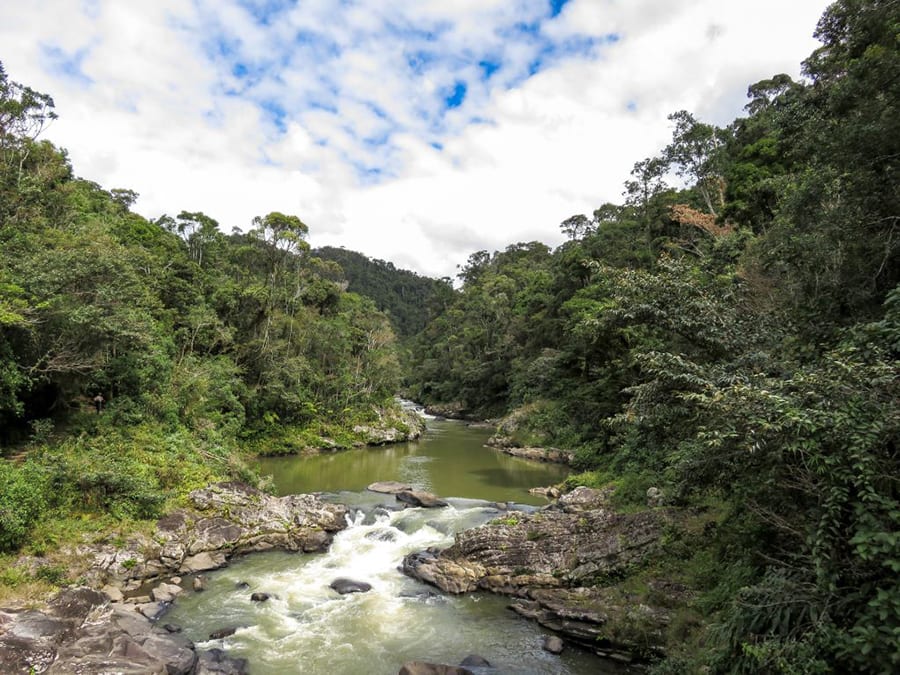
The Rainforests of Atsinanana are located on the eastern side of Madagascar and are made up of six National Parks. While a lot of people think of the island of Madagascar as a lush, forested land, most of the land is deforested or grassland and desert. These rainforests are important to protecting the high numbers of species of plants and animals only found in Madagascar.
Ranomafana National Park is one of the parks included in the UNESCO designation and is a fantastic place to visit to experience the rainforest. On a typical visit to the park, visitors will be lead by a guide through a rainforest to search for wildlife. It’s not uncommon to see several species of bamboo lemur, red-bellied lemurs, and sifakas while hiking through the forest. There are also chameleons, leaf-tailed geckos, and plenty of interesting birds.
While the hiking here can be a bit difficult as it is a mountainous area, the main tourist area has very well maintained paths and stairs. Aside from seeing unique species of wildlife, the landscape here is gorgeous. With rivers, waterfalls, and wide views over the rainforest, Ranomafana is a beautiful UNESCO heritage site in Africa.
Ranomafana is a 10-hour drive from the capital of Antananarivo. There are entry fees for the National Park as well as for hiring a mandatory guide. Having a guide is a good thing as they are very knowledgeable and will point out wildlife that otherwise would be missed. It’s also fantastic that it provides jobs for people from local villages. Ranomafana National Parks is actually divided by the main highway and there are many options for staying in the village of Ranomafana, a short distance away from the main park entry.
Park Entry (a day): 55,000 ariary, $15 US
3 Hour Guided Hike: 75,000 ariary, $20 US
Cairo, Egypt
by Rai from A Rai of Light

Islamic Cairo is a part of central urban Cairo around the old walled city and around the Citadel of Cairo which comprises an array of mosques, tombs, madrasas, mansions, caravanserais, and fortifications dating from the Islamic era.
Established in the 10th century, Historic Cairo was one of the first cities in the Islamic period and shortly after became the centre of the Islamic world. The old city is packed with over 800 classified monuments spanning a period of 1300 years from the 7th century.
The area was proclaimed a World Cultural Heritage site in 1979 as “one of the world’s oldest Islamic cities, with its famous mosques, madrasas, hammams and fountains” and “the new centre of the Islamic world, reaching its golden age in the 14th century.”
It is free to enter and stroll around as the area is open to the public. You cannot miss the huge Al-Azhar mosque and the mix of markets, shops and alleyways that make up the Khan Al-Khalili. This area is also the best to do some shopping, watch a local performance, take photos, and taste some of the best food in Egypt.
YOU MIGHT ALSO LIKE: Unesco Sites Off The Beaten Track – UK
Tunis Medina, Tunisia
by Stephanie from History Fan Girl

The UNESCO site the Medina of Tunis is one of several important medinas, or markets, located in Tunisia. While they’re all lovely, there is something special about Tunis’s market.
Built starting in the eighth century, the medina is typical of the period, but it’s larger and grander than many because of Tunis’s role as a wealthy power centre under the Hafsids. The medina is home to many important and beautiful mosques, including the Kasbah Mosque and the Zitouna Mosque. Another important highlight of any visit to the Tunis Medina is to head up.
The views from the roofs of the medina are simply stunning. While here, make sure to eat a meal or two at one of the medina’s marvellous restaurants. If you’ve never had Tunisian food before, you’ll be delighted by how delicious it is! You can sample local couscous, dates, ojja, and brik to your heart’s content. Of course, you’ll also want to shop, as the medina is packed with shops to explore. There’s everything from spice stores to Tunisian ceramics stands to perfumeries. Make sure to plan your visit on a day when you can go inside some of the mosques, so don’t make Friday the only day you’re able to get here!
Victoria Falls, Zimbabwe
by Lora from Explore with Lora

Victoria Falls is not only a UNESCO World Heritage Site but one of the seven wonders of the natural world. This stunning waterfall is classified as the largest waterfall in the world, given its impressive combined width of 1,708 meters and a height of 108 meters.
Victoria Falls borders between the two African countries of Zimbabwe and Zambia and can be visited from either side. The entrance fee to get into the park to visit the falls on the Zambia side is $20 USD and $30 in Zimbabwe. During the dry season from May to October there is almost no water on the Zambia side, so head over to Zimbabwe for the best views.
What makes a trip to Victoria Falls is special is not only the waterfall but all the amazing adventure activities offered in the area. Vic Falls pours into the Zambezi river, which is home to some of the best river rafting in the world. For epic views of the falls from above, you can take a helicopter tour. Or for those feeling really adventurous, you can even swim in the “devil’s pool” – a small swimming area above the magnificent waterfall. Whatever you choose, there are endless ways to enjoy the beauty of Victoria Falls.
YOU MIGHT ALSO LIKE: UNESCO Sites Off the Beaten Track – The Americas & The Caribbean
Rock Hewn Churches of Lalibela, Ethiopia
by Ioana from The World Is My Playground
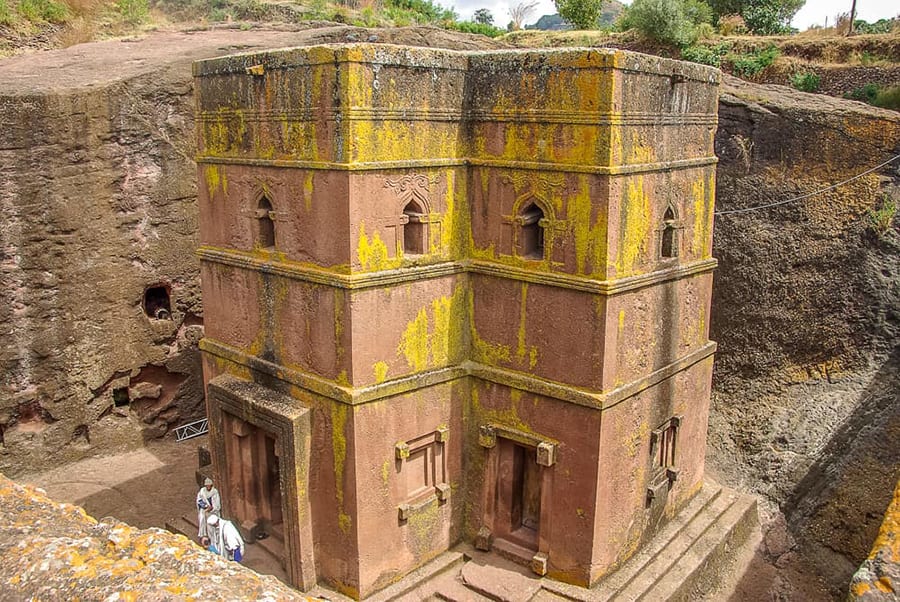
The town of Lalibela, in the Amhara region, is home to 11 very impressive medieval monolithic churches built in the 13th century. Located in the heart of Ethiopia, 645 km north of the country’s capital Addis Ababa, Lalibela is one of the holiest places in the country. However, you’ll enjoy touring these churches and admiring the craftsmanship used to build these incredible structures regardless of your faith and religion.
The churches are special because they are hewn and chiselled out from a single monolithic block and stand below the ground. They were created by King Lalibela who wanted to build a “New Jerusalem” after Christian pilgrimages to the Holy Land were no longer possible.
There are two main groups of churches, to the north and to the south of the river Jordan. The 11th of the group is perhaps also the most popular and unique, and stands isolated from the others, though connected to the rest by a system of trenches. This is the Church of Saint George (or Biete Giyorgis in Amharic) and is one of the best-preserved churches in Lalibela. Cut 40 feet down, the famous church has its roof shaped like a Greek cross.
Each of the 11 churches is unique in its own way. Several are decorated with beautiful and preserved mural paintings, a few of them have openings to catacombs and caves, and each is built in a different shape and size. They’ll all impress you in various ways.
You can only visit the rock-hewn churches with a tour guide, who’ll be able to share insights about their rich history.
Don’t forget to pin this article so you can come back to it later
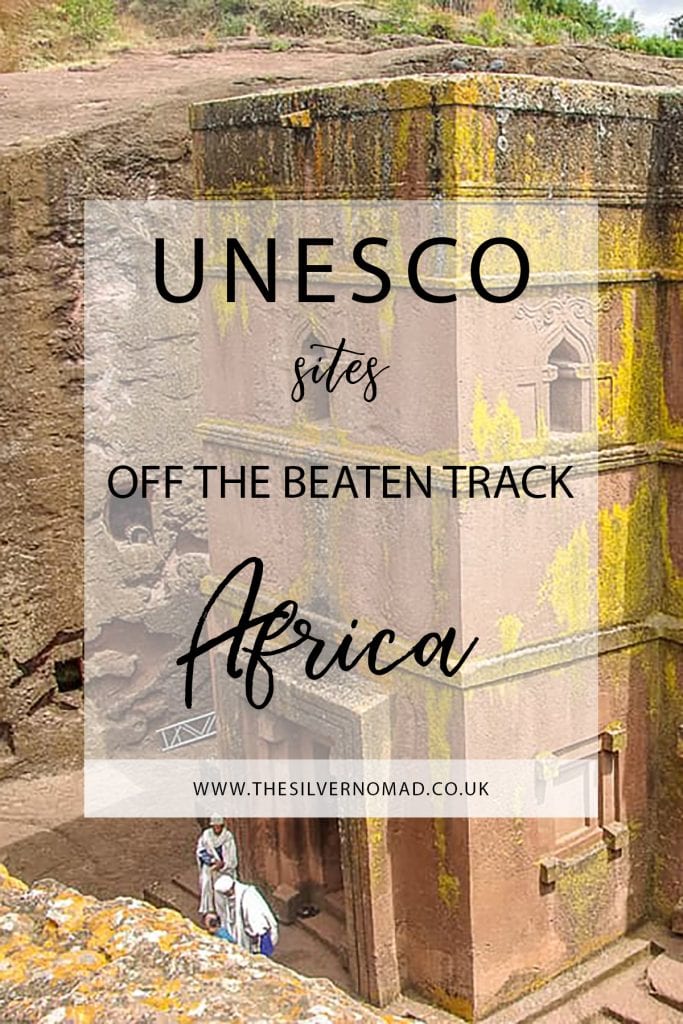



Lovely post, Larch, and looks like I have a few more places to explore! Thanks for giving me the opportunity to contribute.
My pleasure Alma. My travel list has just got longer too!
Learned something new. Namibia and Morocco on my must-see list.
Namibia is on my must-see list for 2020, and hopefully, get back to explore more of Morocco too!
Thank you so much for this post! Africa is a dream destination for me and certainly one I’d love to get off the beaten track a little bit. Botswana and the wildlife looks amazing and I heard it is too. Being in Africa among wildlife and not seeing another car sounds perfect! I’ll certainly be saving this to keep it in my plans!!
Botswana is amazing and the Okavango Delta is a must see! Check my post about FAQ about Safaris in Botswana for some tips!